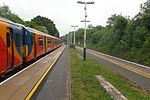Worcester Park House
Worcester Park House, built in 1607, whose ruins are in Surrey, in the United Kingdom, was one of the residences of the 4th Earl of Worcester, who was appointed Keeper of the Great Park of nearby Nonsuch Palace in 1606. During the English Commonwealth the park and house were bought by Colonel Thomas Pride, of Pride's Purge fame. Pride died in the house in 1658. In 1663 a long lease of the house and park was granted to Sir Robert Long, 1st Baronet, by Charles II and a life was added to this lease in 1670. The area known as Worcester Park was once part of a Great Park surrounding the Nonsuch Palace of Henry VIII, and was used extensively for hunting. Samuel Pepys visited Sir Robert Long at Worcester Park House, in November 1665, while the Exchequer was using Nonsuch during the plague. It has been claimed that the first version of the painting The Light of the World (1851–3) by the English Pre-Raphaelite artist William Holman Hunt (1827–1910) was painted at night in a makeshift hut at the house, the other claimant being the garden of the Oxford University PressWorcester Park House burned down in a great fire in 1948. The remaining walls and chimneys were gradually demolished by the youth of the area during the following ten years. Fruit from the abandoned trees of the old orchards was especially welcome in the postwar years. The lake also silted up during this period following improvements to the Hogsmill river. The ruins of a splendid ornamental lake with a multi-arched bridge (at grid reference TQ211654) and balustrade were still visible in the woodland at the foot of the hill in "Parker's Field" (situated between Grafton Road and Old Malden Lane, and behind the still rather ramshackle stables in Grafton Road). The house was positioned so that it had a view of the arches and balustrade.
Excerpt from the Wikipedia article Worcester Park House (License: CC BY-SA 3.0, Authors).Worcester Park House
Grafton Road, Epsom and Ewell West Ewell
Geographical coordinates (GPS) Address Phone number Website Nearby Places Show on map
Geographical coordinates (GPS)
| Latitude | Longitude |
|---|---|
| N 51.37475 ° | E -0.26151 ° |
Address
Linden Bridge School
Grafton Road
KT4 7JW Epsom and Ewell, West Ewell
England, United Kingdom
Open on Google Maps






